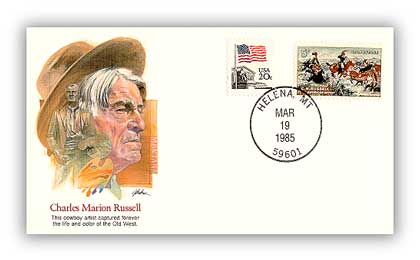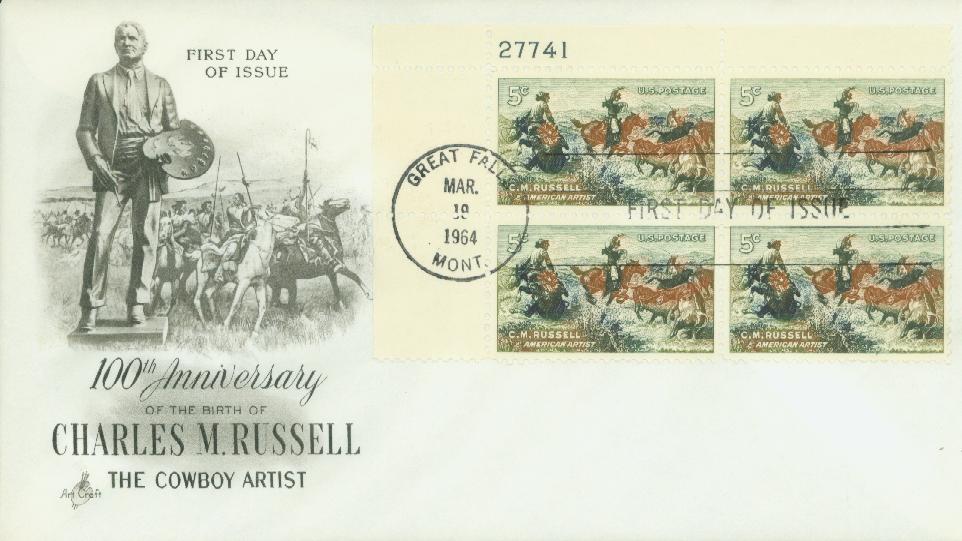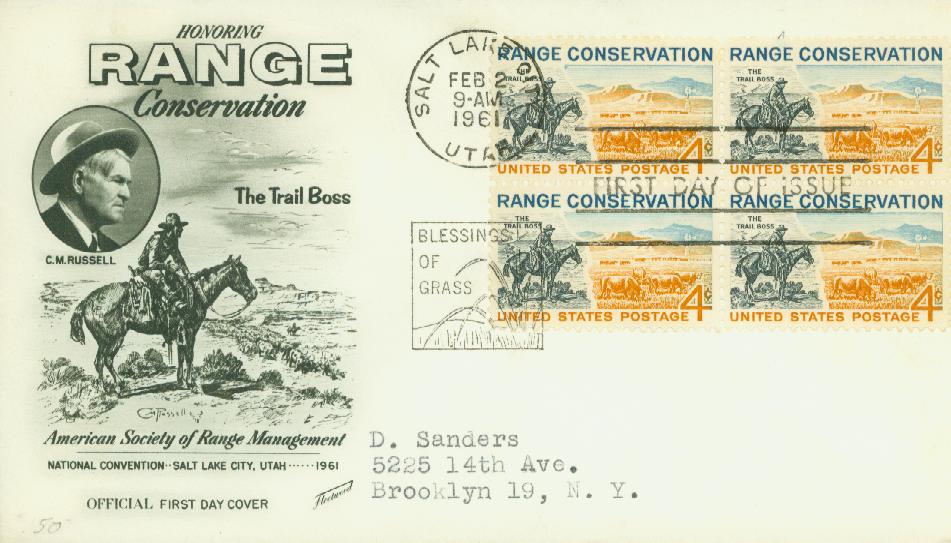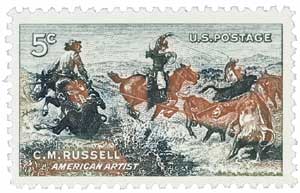
# 1243 PB - 1964 5c Charles M. Russell
5¢ Charles M. Russell
American Painting Series
City: Great Falls, MT
Quantity: 128,025,000
Printed by: Bureau of Engraving and Printing
Printing Method: Giori Press
Perforations: 11
Color: Multicolored
Birth of Charles M. Russell
From an early age, Russell always had a great interest in art. As a child growing up in Missouri, he frequently sketched and made clay figures of animals. He was also very interested in the American West and loved reading stories and listening to the tales of explorers and fur traders passing through town.

Russell always dreamed of being a cowboy in the Wild West, and when he was 16, he set out to fulfill that dream. In 1880, he moved to Montana and first tried his hand working on a sheep ranch. When that didn’t work out, Russell met Jake Hoover, a former hunter and trapper, who started a ranch and hired him. Hoover taught him a lot about living in the west and they would maintain a lifelong friendship. Aside from a brief visit to Missouri in 1882, Russell remained in Montana for the rest of his life.

Over the next few years, Russell worked as a cowboy on several different ranches. In his spare time, he often painted small watercolors of the sights he saw. After the harsh winter of 1886-87, the owner of the O-H Ranch he was working on sent a letter asking how the cattle were doing. Instead of sending back a letter, the ranch foreman sent a postcard-sized watercolor Russell had painted of a lean steer surrounded by wolves. The owner was impressed with the picture and displayed it in a shop window in Helena, Montana.

In 1888, Russell started living with the Blood Indians, part of the Blackfeet nation. He learned a great deal about Native American culture during this time that would later be reflected in his paintings. In 1892, he settled near Great Falls, Montana and decided to commit all his energy to becoming a full-time artist. Within a few years, Russell got married and moved into the city of Great Falls. There he became a local celebrity for detailed artworks. His wife helped him set up shows in the US and London, leading him to gain national and international acclaim.

Russell’s work dramatically recalled his experiences in Montana and brought the Old West to life. Dedicated to his art, Russell created nearly 4,000 scenes during his career. He was also a writer. His “Rawhide Rawlins” stories, published in popular magazines of the day, are among the finest of the period’s western literature.

Russell died on October 24, 1926. On the day of his funeral, all the children in Great Falls were let out of school early to watch his funeral procession.
Click here to view paintings on the official Charles M. Russell website.
5¢ Charles M. Russell
American Painting Series
City: Great Falls, MT
Quantity: 128,025,000
Printed by: Bureau of Engraving and Printing
Printing Method: Giori Press
Perforations: 11
Color: Multicolored
Birth of Charles M. Russell
From an early age, Russell always had a great interest in art. As a child growing up in Missouri, he frequently sketched and made clay figures of animals. He was also very interested in the American West and loved reading stories and listening to the tales of explorers and fur traders passing through town.

Russell always dreamed of being a cowboy in the Wild West, and when he was 16, he set out to fulfill that dream. In 1880, he moved to Montana and first tried his hand working on a sheep ranch. When that didn’t work out, Russell met Jake Hoover, a former hunter and trapper, who started a ranch and hired him. Hoover taught him a lot about living in the west and they would maintain a lifelong friendship. Aside from a brief visit to Missouri in 1882, Russell remained in Montana for the rest of his life.

Over the next few years, Russell worked as a cowboy on several different ranches. In his spare time, he often painted small watercolors of the sights he saw. After the harsh winter of 1886-87, the owner of the O-H Ranch he was working on sent a letter asking how the cattle were doing. Instead of sending back a letter, the ranch foreman sent a postcard-sized watercolor Russell had painted of a lean steer surrounded by wolves. The owner was impressed with the picture and displayed it in a shop window in Helena, Montana.

In 1888, Russell started living with the Blood Indians, part of the Blackfeet nation. He learned a great deal about Native American culture during this time that would later be reflected in his paintings. In 1892, he settled near Great Falls, Montana and decided to commit all his energy to becoming a full-time artist. Within a few years, Russell got married and moved into the city of Great Falls. There he became a local celebrity for detailed artworks. His wife helped him set up shows in the US and London, leading him to gain national and international acclaim.

Russell’s work dramatically recalled his experiences in Montana and brought the Old West to life. Dedicated to his art, Russell created nearly 4,000 scenes during his career. He was also a writer. His “Rawhide Rawlins” stories, published in popular magazines of the day, are among the finest of the period’s western literature.

Russell died on October 24, 1926. On the day of his funeral, all the children in Great Falls were let out of school early to watch his funeral procession.
Click here to view paintings on the official Charles M. Russell website.






